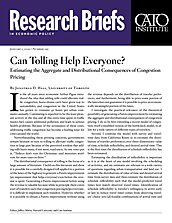In the 98 years since economist Arthur Pigou introduced the idea that adding tolls could alleviate traffic congestion, horse-drawn carts have given way to automobiles, and congestion in the United States has grown to consume 42 hours per urban commuter annually. Commuting is reported to be the least pleasant activity in the day, and all this extra time spent in traffic wastes fuel, causes additional pollution, and leads to serious health problems. Because of the seriousness of these costs, addressing traffic congestion has become a leading issue for cities around the world.
Notwithstanding these pressing concerns, governments remain hesitant to turn to tolling to alleviate traffic congestion in large part because of the perceived wisdom that adding tolls hurts many, if not most, road users. As one voter put it, “Turkeys don’t vote for Christmas—and motorists won’t vote for more taxes to drive.”
The distributional consequence of tolling is the focus of a large amount of literature. I build on this literature and show it is possible for a carefully designed toll applied to a portion of the lanes of the highway to generate a Pareto improvement (an improvement that helps everyone) even before the revenue is spent. Generating a Pareto improvement before using the revenue is valuable because while in principle there exists a set of transfers such that congestion pricing helps everyone, it is difficult to implement such transfers. However, whether it is possible to obtain a Pareto improvement without using the revenue depends on the distribution of traveler preferences, and furthermore, being able to price some portion of the lanes does not guarantee it is possible to price an economically meaningful portion of the lanes.
I investigate the practical relevance of the theoretical possibility of generating a Pareto improvement by estimating the aggregate and distributional consequences of congestion pricing. I do so by first extending a recent model of congestion, itself a modified version of the bottleneck model, to allow for a wide variety of different types of travelers.
Second, I combine the model with survey and travel time data from California Route 91 to estimate the distribution of traveler preferences over three dimensions: value of time, schedule inflexibility, and desired arrival time. This is the first time the distribution of schedule inflexibility has been estimated.
Estimating the distribution of inflexibility is important as it is at the heart of any model involving the scheduling of activities, and my estimates are relevant to a wide variety of questions regarding urban transportation and land use. I estimate the distributions of value of time and desired arrival time from survey data and then estimate the distribution of schedule inflexibility such that the model-predicted travel times best match observed travel times. Identification of schedule inflexibility (a traveler’s willingness to arrive early or late to reduce travel time) comes from observing travelers’ choice sets (all feasible combinations of arrival time and travel time) and using the requirement that travelers choose their optimal solutions.
Third, I use these estimates and my model to evaluate the aggregate and distributional effects of congestion pricing, finding that the welfare gains from congestion pricing are large. Pricing all the lanes increases social welfare by $2,400 per road user per year but at the cost of hurting some road users by $2,390 per year. However, pricing just half the lanes generates a Pareto improvement while still increasing social welfare by $1,740 per road user per year. I extrapolate my results to the rest of the United States by assuming traveler preferences are the same in all cities and adjusting for the severity of congestion and miles traveled in each city. I find that pricing half the lanes on all urban highways would increase social welfare by over $30 billion per year, or $850 per year for the typical urban highway commuter.
NOTE:
This research brief is based on Jonathan D. Hall, “Can Tolling Help Everyone? Estimating the Aggregate and Distributional Consequences of Congestion Pricing,” June 28, 2019, https://individual.utoronto.ca/jhall/documents/Can_Tolling_Help_Everyone.pdf.
